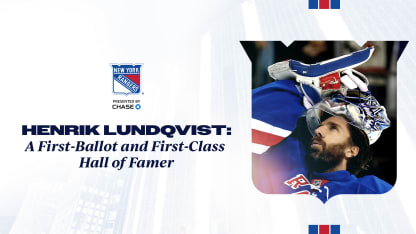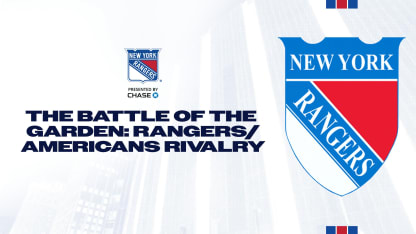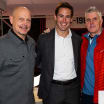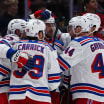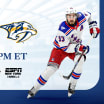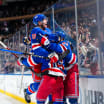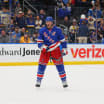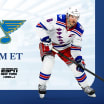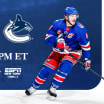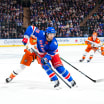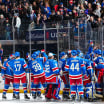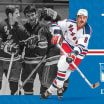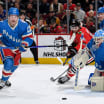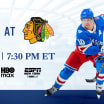Throughout the course of Rangers history, the franchise has been the beneficiary of outstanding goaltending. From one generation to the next – whether it was Dave Kerr, Chuck Rayner, Eddie Giacomin, Mike Richter, Henrik Lundqvist, or Igor Shesterkin – the Blueshirts have developed a legacy of elite goaltending.
One of the special goaltenders that the Rangers were fortunate to have was Lorne “Gump” Worsley, who called New York home for a decade during the 1950s and early 1960s. One of the true characters in hockey history, Worsley left an indelible mark on the franchise and the sport during his Hall of Fame career.
Worsley was born in Montreal in 1929, and he earned the nickname Gump due to his resemblance to comic strip character Andy Gump (both Worsley and Andy Gump had hair that stuck up). Although he was from Montreal, Worsley signed as a teenager with the Verdun Cyclones, a junior team in Quebec that was sponsored by the Rangers.
Over a span of six seasons, Worsley worked his way through the Rangers’ farm system. He had stints in New Haven, St. Paul, Saskatoon, and New York as well (he played with the New York Rovers, the Rangers’ farm team in the Eastern Amateur Hockey League). Although he didn’t have the prototypical stature for a goaltender – he was 5-foot-7 and his weight varied from 160 pounds to 180 pounds throughout his career – Worsley’s acrobatic style helped him achieve impressive results early in his career. In three consecutive seasons from 1948-49 – 1950-51, he was named to the league’s First All-Star Team in three different leagues.
By 1952-53, Worsley got his shot with the Rangers. Rayner, the Hall of Fame goaltender who led the Rangers to within one goal of the Stanley Cup in 1949-50 and won the Hart Trophy as the NHL’s Most Valuable Player that year, had suffered a knee injury and was unable to start the season with the Blueshirts. Worsley stepped in and made his NHL debut in the Rangers’ season opener, and ultimately became the team’s number one goaltender. And although his overall record wasn’t spectacular as part of a young team – 15 different rookies played at least one game for the team that season, including Worsley, Andy Bathgate, and Harry Howell – it was ‘The Gumper’ who won the Calder Trophy as the NHL’s Rookie of the Year.
It appeared as if Worsley would be the mainstay in the Rangers’ net for the foreseeable future. But, he didn’t play a game for the Blueshirts in 1953-54, as Johnny Bower unseated him. Rather than be discouraged, Worsley had a remarkable season with Vancouver of the Western Hockey League, as he was named the league’s MVP and Best Goaltender. He returned to the Rangers the following season, and beginning with the 1955-56 season, he – and the team – began to have considerable success.
The 1955-56 season is the earliest in NHL history which three different statistical categories were tracked for goaltenders – shots faced, saves made, and save percentage. As a result, besides anecdotally remarking on how well a goaltender played, there were numbers that could accentuate that goaltender’s performance.
For Worsley, it just so happened that 1955-56 was his best season, and the results showed the impact he had on the Rangers. When the league – as they did at the time – polled the media for their award picks at the midway point of the season, Worsley was the frontrunner for the Hart Trophy, two points ahead of Montreal’s legendary center Jean Beliveau. At the time, Worsley had a .933 SV%, which was tied for the best in the NHL, and was facing an average of 36.7 shots per game. Performances like the ones he had against the Bruins on November 23 and November 24 of that season – a 36-save shutout that was followed by a 37-save shutout – exemplified the goaltending excellence that Worsley displayed on a consistent basis throughout that season and for the majority of his Rangers’ tenure.
Worsley ultimately played in all 70 regular season games for the Blueshirts in 1955-56, helping the team advance to the playoffs for the first time since 1949-50. But he tore the cartilage in his right knee in a game against the Canadiens in January that limited his effectiveness the rest of the season. He still finished the season with a .923 SV% - and posted a .936 SV% in the 22 games he played which were the second half of a back-to-back set – and finished third in the MVP voting.
Worsley’s tenure with the Rangers lasted through the 1962-63 season, and over that time, he became one of the most popular Blueshirts of his era. He was as quick with his wit as he was moving side to side in the crease. He was named the Rangers’ Most Valuable Player twice. The Rangers Fan Club named him the Most Popular Player on and off the ice three times. He never wore a mask, even in the latter seasons of his tenure after other goalies had started to wear one, saying that his face was his mask.
Worsley was afraid of flying, but never afraid of facing the flying pucks that came his way throughout 21 NHL seasons. Inducted into the Hockey Hall of Fame in 1980, the Gumper won the Stanley Cup four times and the Vezina Trophy twice in his career. At the time of his departure from the Rangers, he had appeared in 581 regular season games with the Blueshirts, more than any other goaltender in franchise history. Six decades later, only two goaltenders have played in more games than Worsley with the franchise – Lundqvist and Richter – and only three goaltenders have earned more wins than him with the franchise – Lundqvist, Richter, and Giacomin.
Gump Worsley was one of a kind and one of the very best in Rangers history.


